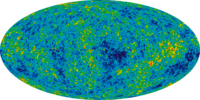
Photo from wikipedia
Two charge density wave transition can be detected in $\mathrm{La}\mathrm{Au}{\mathrm{Sb}}_{2}$ at $\ensuremath{\sim}110$ and $\ensuremath{\sim}90\phantom{\rule{0.16em}{0ex}}\mathrm{K}$ by careful electrical transport measurements. Whereas control of the Au site occupancy in $\mathrm{La}{\mathrm{Au}}_{x}{\mathrm{Sb}}_{2}$ (for $0.9\ensuremath{\lesssim}x\ensuremath{\lesssim}1.0$)… Click to show full abstract
Two charge density wave transition can be detected in $\mathrm{La}\mathrm{Au}{\mathrm{Sb}}_{2}$ at $\ensuremath{\sim}110$ and $\ensuremath{\sim}90\phantom{\rule{0.16em}{0ex}}\mathrm{K}$ by careful electrical transport measurements. Whereas control of the Au site occupancy in $\mathrm{La}{\mathrm{Au}}_{x}{\mathrm{Sb}}_{2}$ (for $0.9\ensuremath{\lesssim}x\ensuremath{\lesssim}1.0$) can suppress each of these transitions by $\ensuremath{\sim}80\phantom{\rule{0.16em}{0ex}}\mathrm{K}$, the application of hydrostatic pressure can completely suppress the lower transition by $\ensuremath{\sim}7.5\phantom{\rule{0.16em}{0ex}}\mathrm{kbar}$ and the upper transition by $\ensuremath{\sim}17\phantom{\rule{0.16em}{0ex}}\mathrm{kbar}$. Clear anomalies in the resistance as well as the magnetoresistance are observed to coincide with the pressures at which the charge density wave transitions are driven to zero.
Journal Title: Physical Review B
Year Published: 2020
Link to full text (if available)
Share on Social Media: Sign Up to like & get
recommendations!